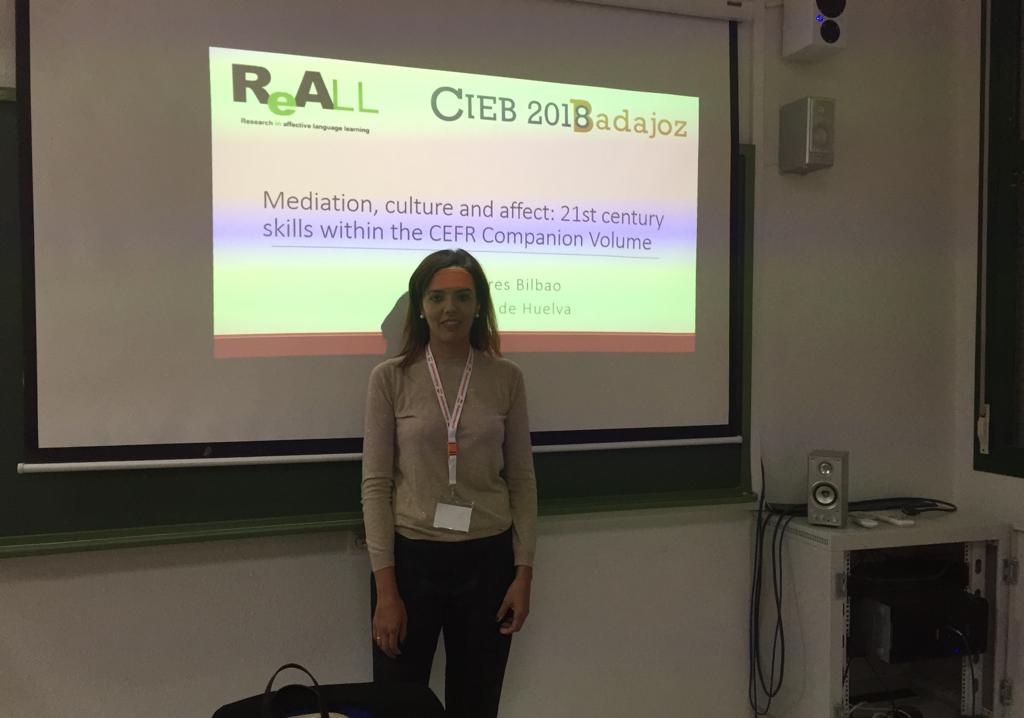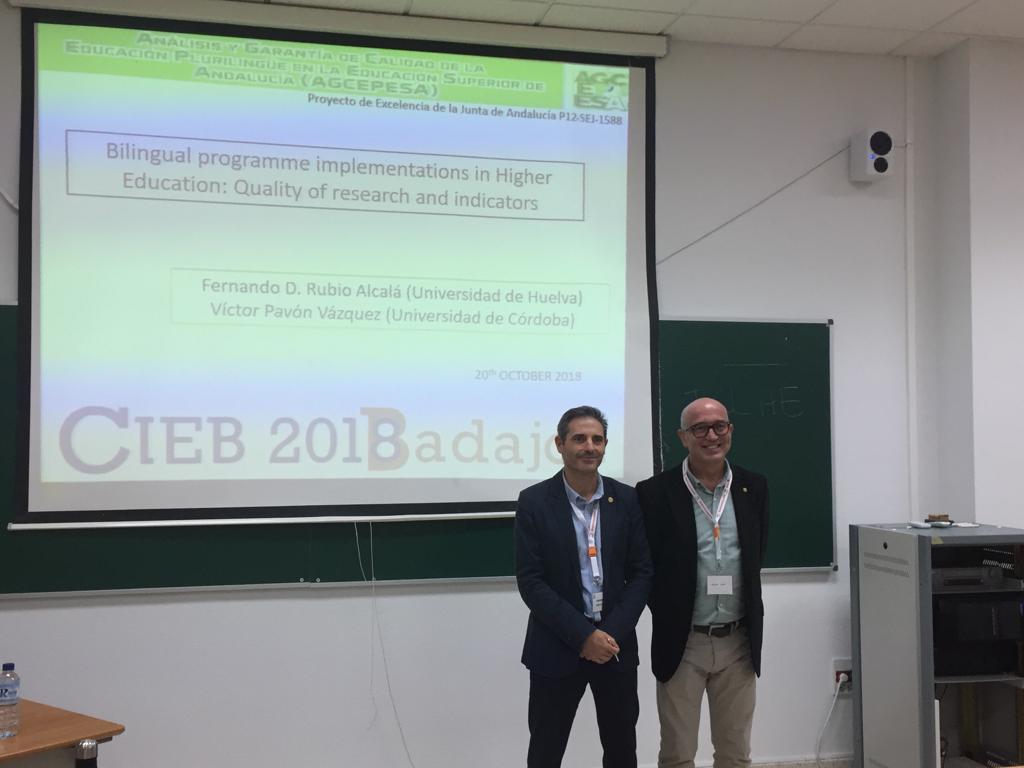Esther Cores Bilbao
Fernando D. Rubio-Alcalá
Two members of our research group presented their latest work at the International Conference for Bilingual Education (CIEB, 19-21 October) held in Badajoz, Spain, a meeting point for researchers, teachers, practitioners and publishers specialized in Content and Language Integrated Learning (CLIL).
The doctoral candidate Esther Cores Bilbao, in her paper “Mediation, Culture and Affect: 21st century skills within the CEFR Companion Volume” analyzed some of the socio-constructivist theoretical contributions that have inspired the update of the CEFR (2001), the paradigm shift spearheaded by the CEFR Companion Volume (CEFR/CV, 2018) and the considerable repercussions that this new document is bound to have for foreign language didactics in the coming years, insofar as it will permeate education policies, determine future teaching goals and inspire best practices like student-teacher interaction in the co-construction of meaning and the recognition of peer learning in the FL acquisition process.
 She also identified some shortcomings present in the CEFR/CV’s theoretical conceptualization of the learner’s emotional dimension, justifying the need to consider the inclusion of affective aspects in CLIL/FLT curricula and practice. She therefore concluded the need to further explore and flesh out specific activities, strategies and assessment tools which help to evaluate emotional and social skills in the FL classroom.
She also identified some shortcomings present in the CEFR/CV’s theoretical conceptualization of the learner’s emotional dimension, justifying the need to consider the inclusion of affective aspects in CLIL/FLT curricula and practice. She therefore concluded the need to further explore and flesh out specific activities, strategies and assessment tools which help to evaluate emotional and social skills in the FL classroom.
Finally, she presented a sneak peak of ReALL’s latest international project, sanctioned by the European Commission, in which alongside six European institutions they will undertake the task of designing mediation-minded teaching materials to test their effect on language and soft-skill development by learners with diverse linguistic backgrounds. This project is called “CEFR mediation strategies: towards a socio-emotionally enhanced plurilingual language education”.
REALL has dedicated its attention in the last years to bilingual education and the influence that CLIL methodology exerts on students and practitioners. It is particularly interesting to note that according to the literature (eg. Pavón and Rubio, 2010) the experience is full of concerns and uncertainties from both teachers and students, who are the focus of attention and are put under stress under the expectancy of successful results. According to Peter Medgyes, who gave the plenary talk “Always look on the bright side- Being a non-native teacher”, many teachers in primary and secondary levels feel insecure because they tend to compare themselves with native teachers. He conducted many studies and found that non-native teachers can have more advantages than the native ones when it comes to facilitating the acquisition of a foreign language. Thus, he concluded that the language competence is just one side of the teachers’ endeavor, and there are other aspects which can also be paramount in the process of language teaching and learning, such as mediation, understanding, L1 competence, etc.
CIEB Badajoz 2018 conference has been a perfect spot to discuss and learn about this issue and many others coming out from experts and practitioners from many different contexts. An important concern for all participants was whether the bilingual experience does really have a positive benefit or impact on learners. María Luisa Pérez Cañado shed some light on the matter in her plenary session “Key factors in successful CLIL programs: Where’s the action going to be?”, and exposed all the rigorous literature that account for those benefits referred to the effects of CLIL on L2 and L1 competence, on content mastery, on pedagogical innovation, on non-elitism, and on catering to diversity.
However, this was referred mostly to pre-university educational levels, since Fernando D. Rubio-Alcalá (member of REALL) and Víctor Pavón, in their presentation “Bilingual programme implementations in Higher Education: Quality of research and indicators”, showed the results of a research project in which a systematic review was conducted, and reported that quality research in Higher Education is scarce and more experimental research designs need to be done. They also exposed a tool composed of indicators that can be used to measure bilingual programs in terms of effectiveness and quality. The tool has been designed from debates that took place in three symposia in the framework of the research project AGCEPESA, formed by a group of 26 experts (funded by Junta de Andalusia, Ref P12-SEJ-1588), from publications selected from a systematic review (Rubio-Alcalá et al.) and from other important documents (Bazo et al.). It is organized into four main factors: organization, curriculum, teachers and students’ incentives and evaluation. The items indicate procedures to be adopted when launching or developing bilingual degrees in Higher Education, for instance, it indicates that teachers should have accredited a C1 level of language competence, or students a B2 level to participate in the program.
 Plenary sessions aside, CIEB 2018 also featured a staggering 78 presentations and 29 thematic workshops, with topics ranging from methodology, best practices and teaching experiences to evaluation, student and teacher perception and identification of future research areas. A particularly interesting contribution was that by prof. Cristina Pérez Guillot, “Estimulación Auditiva Neurosensorial y la Enseñanza de Lenguas: Nuevas Propuestas Metodológicas”, which relayed the findings of an empirically substantiated research project on the TOMATIS method. Collaborating with a team of medical professionals, prof. Pérez Guillot claims to have succeeded in broadening the audible spectrum that test subjects can distinguish. According to her promising results, when transferred to the LL context the TOMATIS method supports the development of receptive listening skills and productive oral skills, and the attainment of new competence levels in half the time as the average required by students who do not receive aural stimulation.
Plenary sessions aside, CIEB 2018 also featured a staggering 78 presentations and 29 thematic workshops, with topics ranging from methodology, best practices and teaching experiences to evaluation, student and teacher perception and identification of future research areas. A particularly interesting contribution was that by prof. Cristina Pérez Guillot, “Estimulación Auditiva Neurosensorial y la Enseñanza de Lenguas: Nuevas Propuestas Metodológicas”, which relayed the findings of an empirically substantiated research project on the TOMATIS method. Collaborating with a team of medical professionals, prof. Pérez Guillot claims to have succeeded in broadening the audible spectrum that test subjects can distinguish. According to her promising results, when transferred to the LL context the TOMATIS method supports the development of receptive listening skills and productive oral skills, and the attainment of new competence levels in half the time as the average required by students who do not receive aural stimulation.
A general understanding in the conference was that CLIL implementation is still quite recent and patience is a key word. Despite the fact that successful evidences were reported, teachers, students, parents, researchers, politicians and other stakeholders still need to keep working hard and in the right direction for the development of plurilingualism.
References
Council of Europe. (2002). Common European Framework for Languages: Learning, Teaching, Assessment. Centro Virtual Cervantes. https://doi.org/10.1007/s13398-014-0173-7.2
Council of Europe. (2018). Common European framework of reference for languages: Learning, teaching, assessment companion volume with new descriptors. Consejo de Europa (Vol. 13). https://doi.org/10.1017/CHOL9780521221283
Pavón Vázquez, V., & Rubio-Alcalá, F.D. (2010). Teachers’s concerns and uncertainties about the introduction of CLIL programmes. Porta Linguarum: Revista Internacional de Didáctica de Las Lenguas Extranjeras, 14(14), 45–58.
Rubio-Alcalá, F.D., Arco-Tirado, J.L., Fernández-Martín, F.D., López-Lechuga, R., Barrios-Espinosa, E., and Pavón Vázquez, V. (2019). A Systematic Review on Evidences Supporting Quality Indicators of Bilingual Programs in Higher Education. In review process.
Bazo Martínez, P. and González Álvarez, Dolores. (2016). Documento marco de política lingüística para la internacionalización del sistema universitario español. CRUE.
